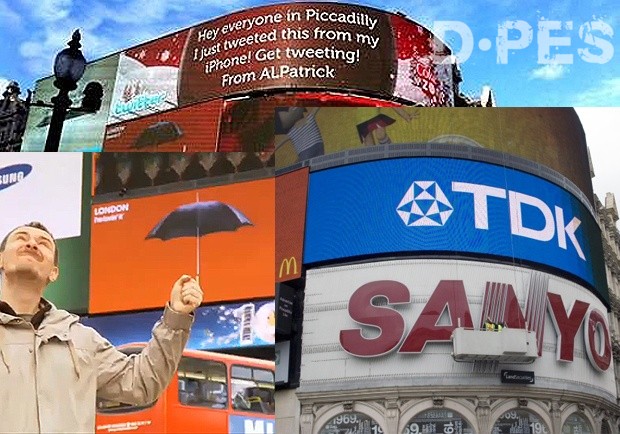2011 review and 2012 preview: big, small, increasingly ubiquitous - don't fear the screen
For reasons obvious to anyone who has ever been there, London's Piccadilly Circus is the heart of high-visibility, high-cost digital signage in the UK. Like Time Square, it is a symbol of commercial exposure and success, a testing ground for the global Goliaths of advertising spend and innovation, a beacon of change for commerce and industries, and an ideal place to begin our round-up of the most exciting digital signage of 2011 and what to look out for in 2012.
Before Christmas McDonald's began a feel-good campaign on their giant digital billboard at the Circus which featured images of simple objects against a red McDonald's background. The images were sized so that tourists, pedestrians and passersby could pose on the streets below and, to a camera, appear to be holding the objects in question. The result: fun for consumers, who got an unusual photographic souvenir at one of London's most famous squares, and good for the company, which got happy, smiling people to immortalise their own personal merry-made scenes before a backdrop of McDonald's branding.

Three signs, three approaches to large-format digital signage. Look for more formats, sizes and approaches in 2012
Also before Christmas, not 30m above the McDonald's signage, Coca-Cola ran its own experiment in interactive advertising on its huge-format, high-visibility digital billboard. Less tactile, more networked and, when it worked, perhaps more satisfying to consumers, health-nuts and Coke-lovers alike were invited to tweet messages to @cokezone. The messages were then moderated and displayed in huge digital letters above the heads of scurrying shoppers and busy Londoners for the world to see. ('Marry me @anyone' was a personal favourite.)
So what can the rest of us learn from all this? What can owners of smaller networked or individual digital signage screens take away from the Piccadilly Circus Titans? Mainly, the growing value and increasing ubiquity of interactivity.
The McDonald's campaign is impressive because of the size of media in question and thanks to the fame of venue. But compared to what some interactive digital signage platforms are installing, the idea is a crude stab at using technology to engage potential customers. Take augmented reality developer Hidden's Gesture Controlled Window Display and Gesture Controlled Catalogue, which let passersby browse inventory both in and outside stores. If they like what they see, they might be converted from casual pedestrian to paying customer.
While companies like Monster Media are designing campaigns for IBM in DOOH spaces which take advantage of time, space, motion and vision to deliver immersive marketing content from the ground up, other companies like Omek and GestureTek are developing interaction-enabling retrofits for existing digital signage like freestanding wall and floor projectors and adaptable 3D camera sensors.
As for attempts to encourage digital signage interaction via smartphones, Coca-Cola's Twitter idea is, again, large and loud and impressive in venue but crude when it comes to immersing participants in what's on screen. Out-of-home advertising specialist Eye collaborated with game manufacturer Sega to deliver a networked augmented reality game for Australian shopping centres. Shoppers who download the game's app earn points by snapping pictures of the famous Sega character Sonic the Hedgehog as he whizzes from screen to screen around the mall in which audio and visual cues alert players to when and from where Sonic might arrive.
When 2011 began, mounted on the very same building below Coca-Cola and to the right of McDonald's overlooking Piccadilly Circus, Sanyo's billboard – not a state-of-the-art LED capable of displaying advanced graphics – was already a reminder of how far digital signage had come. The Japanese electronics manufacturer had owned the space, which sees up to 56m passersby annually, since 1978, and in 2011 the company decided not to renew its contract for the space.
So from Sanyo, perhaps we can learn that increasingly, bigger is not always better. We don't need to spend millions to reach millions if the few consumers we do reach are immersed and impressed enough by our message that they can't look anywhere else.
In 2012, look out for more screens and more immersion and more hardware, software and platforms for encouraging interaction with digital signage. But most of all, look out for digital signage to penetrate further into the lives of the average consumer as more and more small-scale companies and networks find value in screens of all sizes.